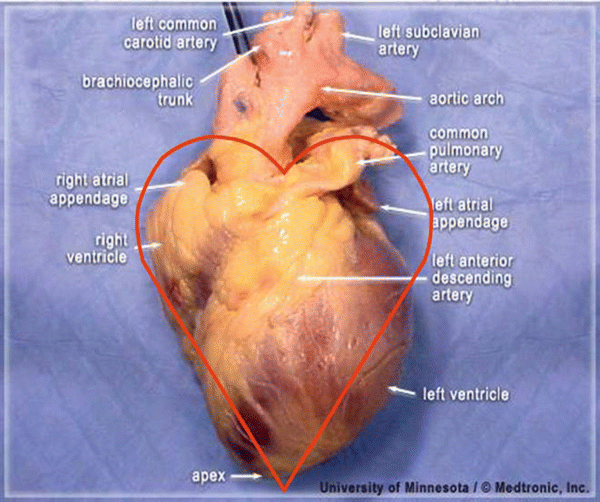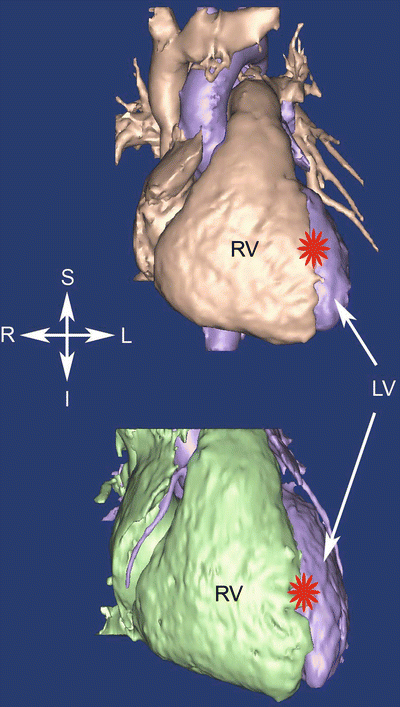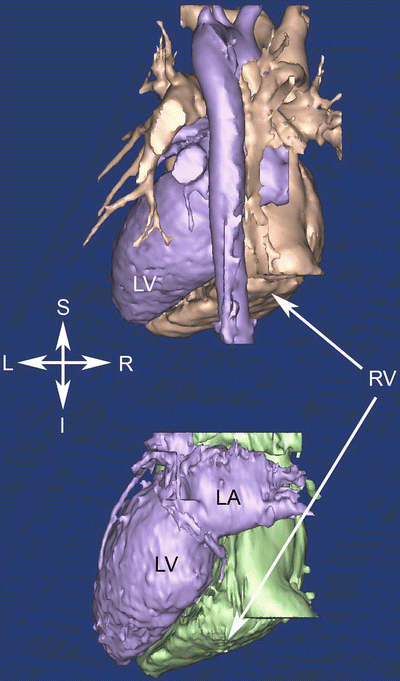Fig. 2.1
Illustration showing the anatomic position. Regardless of the position of the body or organ upon examination, the anatomy of an organ or the whole should be described as if observed from this vantage point. The anatomic position can be divided by three separate orthogonal planes: (1) the sagittal plane, which divides the body into right and left portions; (2) the coronal plane, which divides the body into anterior and posterior portions; and (3) the transverse plane, which divides the body into superior and inferior portions
2.2 The Problem: Cardiac Anatomy Does Not Play by the Rules
As described above, the use of the anatomic position has stood the test of time and is still used to describe the position of structures within the body. However, within approximately the last 50 years, descriptions of cardiac anatomy have not adhered to the proper use of these terms; rather they have been replaced with inappropriate descriptors. There are two major reasons for this: (1) many descriptions of heart anatomy have been made with the heart removed from the body and incorrectly positioned during examination, and (2) a heart-centric orientation has been preferred to describe the structures. These two reasons are interrelated and negatively affect the proper description of cardiac anatomy. Typically, when the heart is examined outside the body, it has been placed on its apex into the so-called Valentine position, which causes the heart to appear similar to the common illustration of the heart used routinely in everything from greeting cards to instant messenger icons (Fig. 2.2). It is the author’s opinion that this problem has been confounded by the comparative positional differences seen between humans and large mammalian cardiac models used to help understand human cardiac anatomy and physiology. As you will see in the following sections, the position of the heart within a sheep thorax is very similar to the Valentine position used to examine human hearts. I will point out that I have been guilty of describing structures in such a manner, as is evidenced by some of the images available in the Visible Heart® Viewer CD (Fig. 2.2), as have countless others as seen in the scientific literature and many textbooks (even including this one). Regardless, it is a practice I have since given up and have reverted to the time-honored method using the anatomic position.


Fig. 2.2
A human heart viewed from the so-called anterior position, demonstrating the Valentine heart orientation used by many to incorrectly describe anatomy. The red line surrounding the heart is the characteristic symbol, which was theoretically derived from observing the heart in the orientation
Further impacting the incorrect description of cardiac anatomy is the structure of the heart itself. A common practice in examining the heart is to cut the ventricular chambers in the short axis, which is perpendicular to the long axis of the heart which runs from the base to the apex. This practice is useful in the examination of the ventricular chambers, but the cut plane is typically confused as actually being transverse to the body when it is, in most cases, an oblique plane. The recent explosion of tomographic imaging techniques, such as magnetic resonance imaging (MRI) and computed tomography (CT), in which cuts such as the one just described are commonly made, has further fueled the confusion.
Nevertheless, this incorrect use of terminology to describe the heart can be considered to impact a large and diverse group of individuals. Practitioners of medicine, such as interventional cardiologists and electrophysiologists, are affected, as are scientists investigating the heart and engineers designing medical devices. It is considered here that describing terms in a more consistent manner, and thus using the appropriate terminology, would greatly increase the efficiency of interactions between these groups.
It should be noted that there have been a few exceptions to this rule, in that attempts have been made to promote proper use of anatomic terminology. Most notable are the works of Professor Robert Anderson [3–6], although he will also admit that he has been guilty of using incorrect terminology in the past. Other exceptions to this rule are Wallace McAlpine’s landmark cardiac anatomy textbook [7] and an excellent textbook by Walmsley and Watson [8].
In addition to these exceptions, a small group of scientists and physicians has begun to correct the many misnomers that have been used to describe the heart in the recent past; this is the major goal of this chapter. A description of the correct position of the heart within the body will be presented along with specific problem areas, such as the coronary arteries, where terms such as left anterior descending artery are most obviously incorrect and misleading.
2.3 The Attitudinally Correct Position of the Human Heart
The following set of figures used to describe the correct position of the heart within the body was created from 3D volumetric reconstructions of magnetic resonance images of healthy humans with normal cardiac anatomy. In Fig. 2.3, the anterior surfaces of two human hearts are shown. Note that in this view of the heart, the major structures visible are the right atrium and right ventricle. In reality, the right ventricle is positioned anteriorly and to the right of the left ventricle. Also, note that the apex of the heart is positioned to the left and is not inferior, as in the Valentine position. Furthermore, note that the so-called anterior interventricular sulcus (shown with a red star), in fact, begins superiorly and travels to the left and only slightly anteriorly. Figure 2.4 shows the posterior surfaces of two human hearts, in which the first visible structure is the descending aorta. Anterior to that are the right and left atria. Figure 2.5 shows the inferior or diaphragmatic surfaces of two human hearts, commonly referred to as the posterior surface, based on Valentine positioning. The inferior caval vein and descending aorta are cut in the short axis; in this region of the thorax, they tend to travel parallel to the long axis of the body. Note that the so-called posterior interventricular sulcus is actually positioned inferiorly (shown with a red star). Figure 2.6 shows a superior view of two human hearts. In this view, the following structures are visible: (1) the superior caval vein, (2) the aortic arch and the major arteries arising from it, (3) the free portion of the right atrial appendage, and (4) the pulmonary trunk which, after arising from the right ventricle, runs in the transverse plane before bifurcating into the right and left pulmonary arteries. Also, note that the position of the anterior interventricular sulcus (shown with a red star) is more correctly termed superior.

 < div class='tao-gold-member'>
< div class='tao-gold-member'>





Fig. 2.3
Volumetric reconstructions from magnetic resonance imaging showing the anterior surfaces of two human hearts . The major structures visible are the right atrium and right ventricle. The apex of the heart is positioned to the left and is not inferior as in the Valentine position. The so-called anterior interventricular sulcus (shown with a red star) in fact begins superiorly and travels to the left and only slightly anteriorly. I inferior, L left, LV left ventricle, R right, RV right ventricle, S superior

Only gold members can continue reading. Log In or Register to continue
Stay updated, free articles. Join our Telegram channel

Full access? Get Clinical Tree


